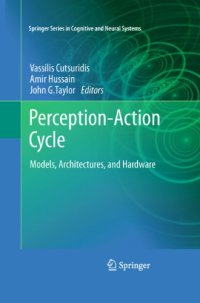
Ebook: Perception-Action Cycle: Models, Architectures, and Hardware
Author: John K. Tsotsos Albert L. Rothenstein (auth.) Vassilis Cutsuridis Amir Hussain John G. Taylor (eds.)
- Genre: Art // Design: Architecture
- Tags: Neurosciences, Computation by Abstract Devices, Neurobiology, Signal Image and Speech Processing
- Series: Springer Series in Cognitive and Neural Systems
- Year: 2011
- Publisher: Springer-Verlag New York
- Edition: 1
- Language: English
- pdf
The perception-action cycle is the circular flow of information that takes place between the organism and its environment in the course of a sensory-guided sequence of behavior towards a goal. Each action causes changes in the environment that are analyzed bottom-up through the perceptual hierarchy and lead to the processing of further action, and top-down through the executive hierarchy toward motor effectors. These actions cause new changes that are analyzed and lead to new action, and so the cycle continues.
The Perception-Action cycle: Models, Architectures and Hardware book provides focused and easily accessible reviews of various aspects of the perception-action cycle. It is an unparalleled resource of information that will be an invaluable companion to anyone in constructing and developing models, algorithms, and hardware implementations of autonomous machines empowered with cognitive capabilities.
The book is divided into three main parts. In the first part, leading computational neuroscientists present brain-inspired models of perception, attention, cognitive control, decision making, conflict resolution and monitoring, knowledge representation and reasoning, learning and memory, planning and action, and consciousness grounded in experimental data. In the second part, architectures, algorithms, and systems with cognitive capabilities and minimal guidance from the brain are discussed. These architectures, algorithms, and systems are inspired by cognitive science, computer vision, robotics, information theory, machine learning, computer agents, and artificial intelligence. In the third part, the analysis, design, and implementation of hardware systems with robust cognitive abilities from the areas of mechatronics, sensing technology, sensor fusion, smart sensor networks, control rules, controllability, stability, model/knowledge representation, and reasoning are discussed.
About the Editors:
Vassilis Cutsuridis is a Senior Research Scientist at the Center for Memory and Brain at Boston University, Boston, USA.
Amir Hussain is a Reader in Computing Science in the Department of Computing Science and Mathematics at the University of Stirling, UK.
John G. Taylor is an Emeritus Distinguished Professor of Mathematics in the Department of Mathematics at King’s College, London, UK.
The perception-action cycle is the circular flow of information that takes place between the organism and its environment in the course of a sensory-guided sequence of behaviour towards a goal. Each action causes changes in the environment that are analyzed bottom-up through the perceptual hierarchy and lead to the processing of further action, top-down through the executive hierarchy, toward motor effectors. These actions cause new changes that are analyzed and lead to new action, and so the cycle continues. The Perception-action cycle: Models, architectures and hardware book provides focused and easily accessible reviews of various aspects of the perception-action cycle. It is an unparalleled resource of information that will be an invaluable companion to anyone in constructing and developing models, algorithms and hardware implementations of autonomous machines empowered with cognitive capabilities. The book is divided into three main parts. In the first part, leading computational neuroscientists present brain-inspired models of perception, attention, cognitive control, decision making, conflict resolution and monitoring, knowledge representation and reasoning, learning and memory, planning and action, and consciousness grounded on experimental data. In the second part, architectures, algorithms, and systems with cognitive capabilities and minimal guidance from the brain, are discussed. These architectures, algorithms, and systems are inspired from the areas of cognitive science, computer vision, robotics, information theory, machine learning, computer agents and artificial intelligence. In the third part, the analysis, design and implementation of hardware systems with robust cognitive abilities from the areas of mechatronics, sensing technology, sensor fusion, smart sensor networks, control rules, controllability, stability, model/knowledge representation, and reasoning are discussed.